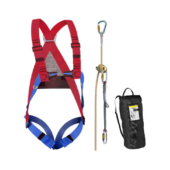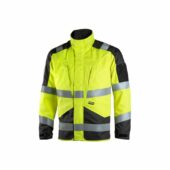Managing vibration exposure is essential for maintaining worker health and productivity in industries like construction and manufacturing. EN ISO 10819, a key standard for evaluating anti-vibration gloves, provides a reliable way to protect workers from various challenges.
This guide will explain everything you need to know to confidently choose the best gloves for your needs, ensuring compliance, safety, and comfort.
As a bonus, we’ll also guide you on what to consider next once you’ve selected the right gloves. For those ready to dive deeper into glove options, explore our comprehensive buyer’s guide.
What Is EN ISO 10819?
The EN ISO 10819 standard specifies the methods for testing and measuring the effectiveness of gloves in reducing vibrations. Designed primarily for workers exposed to hand-arm vibration, such as those using power tools, the standard ensures gloves meet performance criteria for vibration reduction.
- Purpose: Protect users from vibration-induced injuries, such as Hand-Arm Vibration Syndrome (HAVS).
- Scope: Focuses on mechanical vibrations transmitted from tools to the hands.
- Key Metrics: Tests gloves’ ability to dampen medium- and high-frequency vibrations.
You can learn more about the technical specifications from authoritative sources like ISO.org and GuideGloves.com.
Why EN ISO 10819 Matters
Industries like construction, manufacturing, and forestry benefit greatly from managing vibration exposure effectively. Proper protective measures help prevent grip fatigue, nerve discomfort, and circulation challenges. By using gloves that meet the EN ISO 10819 standard, workers can minimize these risks effectively.
Key Benefits:
- Compliance with Regulations: European workplaces are legally required to manage vibration exposure. Gloves meeting this standard help employers meet safety directives.
- Worker Safety: Reduces the risk of long-term injuries.
- Enhanced Productivity: Workers experience less fatigue, enabling them to perform tasks more effectively.
If you’re interested in gloves that address specific risks, explore our range of anti-vibration gloves.
Testing Procedures for EN ISO 10819
Understanding how gloves are tested under EN ISO 10819 helps in selecting the right product. The standard evaluates gloves by measuring their vibration attenuation properties across different frequency ranges.
- Medium-Frequency Range (31.5 to 200 Hz): Gloves must achieve a vibration reduction rate of at least 40%.
- High-Frequency Range (200 to 1250 Hz): Gloves must achieve a vibration reduction rate of at least 10%.
- Testing Setup: Simulates real-world conditions by using tools and vibration sources common in the workplace.
This ensures that certified gloves deliver reliable protection. For more about selecting gloves, consult How to Choose the Right Work Gloves.
Features to Look for in EN ISO 10819-Certified Gloves
When purchasing anti-vibration gloves, focus on these features:
- Material Composition: High-quality padding materials like foam or gel for effective vibration dampening.
- Ergonomics: Ensure gloves provide dexterity and comfort during prolonged use.
- Durability: Look for abrasion-resistant materials that withstand tough environments.
Explore a curated selection of impact-resistant gloves for additional safety against mechanical shocks.
Comparing EN ISO 10819 with Other Standards
While EN ISO 10819 is the primary standard for vibration dampening gloves, other standards like EN 388 (mechanical protection) and EN 420 (general glove requirements) may also be relevant.
| Standard | Focus Area | Relevance |
| EN ISO 10819 | Vibration reduction | Essential for vibration-intensive work. |
| EN 388 | Cut, tear, and abrasion resistance | Useful in environments with sharp objects. |
| EN 420 | General glove performance | Ensures fit, safety, and comfort. |
For multi-hazard protection, consider cut-resistant gloves alongside anti-vibration gloves.
Practical Applications of EN ISO 10819 Gloves
Anti-vibration gloves are indispensable for workers using tools such as:
- Impact Drills: Reduce shock from repetitive impacts.
- Chainsaws: Minimize vibration from motorized cutting.
- Grinders: Protect hands from tool vibration over long shifts.
Combining these gloves with proper safety shoes can further enhance workplace safety.
How to Choose the Right Anti-Vibration Gloves

Selecting gloves certified under EN ISO 10819 can be straightforward if you follow these steps:
- Assess Your Needs: Consider the tools and frequency of vibration exposure.
- Check Certification: Verify compliance with EN ISO 10819.
- Fit and Comfort: Ensure the gloves allow sufficient dexterity for your tasks.
For a detailed buying guide, visit How to Choose the Right Anti-Vibration Gloves.
Related Resources
If you’re exploring other types of protective gear, check out these guides:
- How to Choose Cut-Resistant Gloves
- How to Choose the Right Impact-Resistant Gloves
- Selecting the Best Leather Work Gloves
Conclusion
We hope this guide has helped you understand the essentials of the EN ISO 10819 standard and how it supports worker safety in vibration-prone industries.
By choosing gloves that meet this standard, you can confidently address vibration hazards and ensure compliance with workplace safety requirements. Explore our anti-vibration gloves collection to find trusted, certified options for your needs.
If you have further questions or are looking for additional protective solutions, such as impact-resistant or cut-resistant gloves, we’re here to guide you every step of the way.
Frequently Asked Questions
Look for certification labels on the glove or check the manufacturer’s documentation. Reputable brands typically provide detailed compliance information, including testing results.
No, these gloves are designed specifically to reduce mechanical vibrations in medium- and high-frequency ranges. For other types of vibration or impact, additional protective features may be necessary.
Replacement depends on wear and tear, the frequency of use, and the conditions in which they are used. Inspect gloves regularly for signs of degradation, such as thinning padding or tears, and replace them as needed.
Many anti-vibration gloves are not designed for extreme hot or cold environments. If temperature protection is required, look for gloves with additional insulation or heat-resistant features.
Yes, while these gloves reduce vibration, they cannot eliminate it entirely. They are most effective when used in conjunction with proper tool maintenance and safe work practices. Ensure that tools are functioning correctly and follow recommended exposure limits for vibration.

















